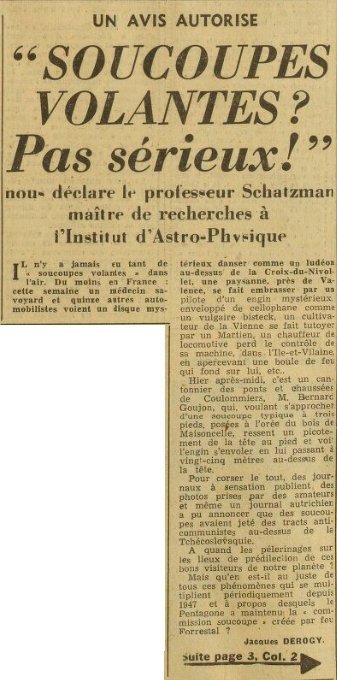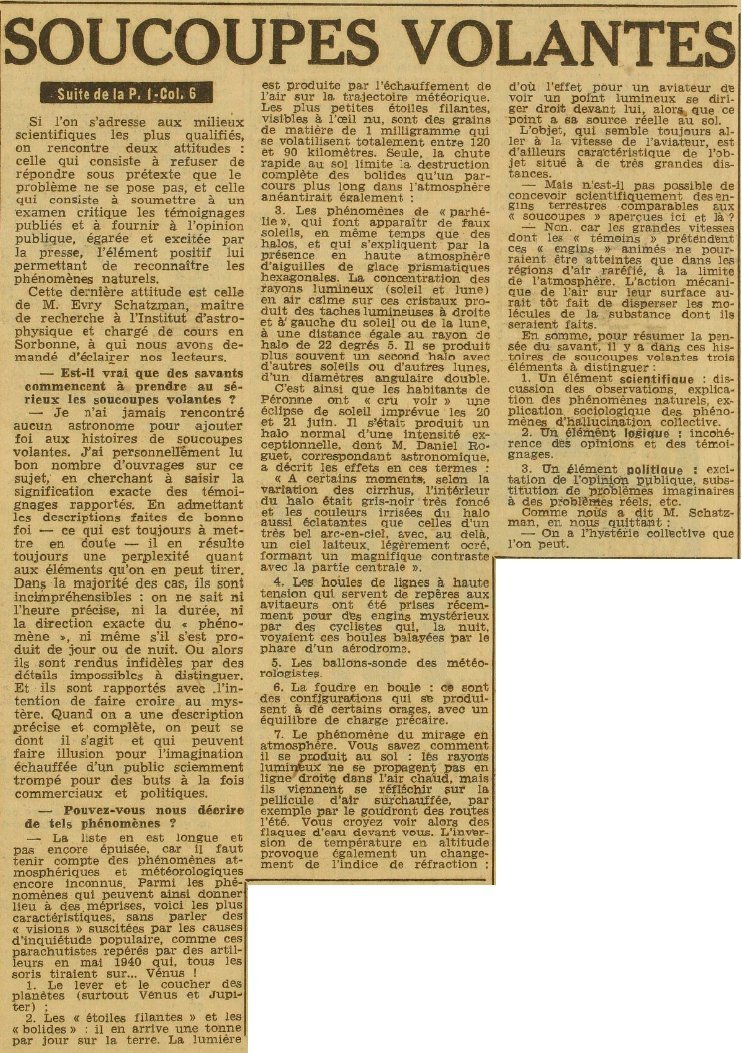
The index page for the 1954 French flap section of this website is here.
Reference for this case: 20-Jun-54-Péronne.
Please cite this reference in any correspondence with me regarding this case.
The very "skeptical" national newspaper Libération of October 2, 1954, published an interview with astronomer Evry Schatzman, a member of the Rationalist Union, in which he explained that "flying saucers" were a "psychosis" caused by the sensationalist press, by "science fiction writers," and based on ordinary natural phenomena mistaken for "flying saucers" by their witnesses.
One of the examples of such natural phenomena cited by Evry Schatzman was the perihelion, a phenomenon that causes false suns to appear along with halos, and which is explained by the presence of hexagonal prismatic ice crystals in the upper atmosphere: "The concentration of light rays (from the sun and moon) in still air on these crystals produces luminous spots to the right and left of the sun or moon, at a distance equal to the 22.5-degree halo radius. A second halo often forms with other suns or moons, with an angular diameter twice as large."
Evry Schatzman gave this example:
This is how the inhabitants of Péronne thought they had seen an unexpected solar eclipse on June 20 and 21. A normal halo of exceptional intensity had formed, which Mr. Daniel Roguet, an astronomical correspondent, described in the following terms:
"At certain moments, depending on the variation of the cirrus clouds, the inside of the halo was a very dark gray-black and the iridescent arcs of the halo were as bright as those of a very beautiful rainbow, with, beyond, a milky, slightly ochre sky forming a magnificent contrast with the central part."
[Ref. lin1:] NEWSPAPER "LIBERATION":

|
There have never been so many "flying saucers" in the air. At least in France: this week, a doctor from Savoy and fifteen other motorists saw a mysterious disc dancing like a spinning top above the Croix-du-Nivollet, a peasant woman near Valence was kissed by the pilot of a mysterious craft, wrapped in cellophane like a common steak, a farmer from Vienne was addressed informally by a Martian, a locomotive engineer lost control of his engine in Ille-et-Vilaine after seeing a fireball hurtling toward him, etc.
Yesterday afternoon, a road maintenance worker from Coulommiers, Mr. Bernard Goujon, tried to approach a typical three-legged saucer that had landed at the edge of the Maisoncelle woods. He felt a tingling from head to toe and saw the craft take off, flying over him at a height of twenty-five meters.
To spice things up, tabloid newspapers are publishing photos taken by amateurs, and even an Austrian newspaper claimed that saucers had dropped anti-communist leaflets over Czechoslovakia.
When will the pilgrimages begin to the favorite haunts of these visitors from our planet?
But what exactly is going on with all these phenomena that have been recurring periodically since 1947, and about which the Pentagon has kept the "saucer commission" created by the late Forrestal?
Jacques DEROGY
Continued on page 3, Col. 2

|
Continued from Page 1 - Col. 6
If you turn to the most qualified scientific circles, you'll encounter two attitudes: one that refuses to answer on the grounds that the problem does not exist, and another that critically examines the published testimonies and provides the public - misled and stirred up by the press - with the facts necessary to recognize natural phenomena.
The latter attitude is that of Mr. Evry Schatzman, research director at the Institute of Astrophysics and lecturer at the Sorbonne, whom we asked to enlighten our readers.
Is it true that scientists are beginning to take flying saucers seriously?
- I have never met a single astronomer who gives credence to the flying saucer stories. I have personally read a good number of books on the subject, trying to grasp the true meaning of the reported testimonies. Even assuming the descriptions are made in good faith - which is always questionable - they still result in confusion about what conclusions can be drawn. In the majority of cases, the reports are incomprehensible: one does not know the exact time, duration, or direction of the phenomena, nor even whether it occurred by day or night. Or else the reports are distorted by details that are impossible to distinguish. And they are often shared with the intent to create a sense of mystery. When a description is precise and complete, one can determine what it refers to - and these are often illusions shaped by the overheated imagination of a public deliberately misled for both commercial and political reasons.
Can you describe such phenomena for us?
The list is far from exhausted, as we must also consider still-unknown atmospheric and meteorological phenomena. Among those most commonly mistaken for something else are the following, not to mention the visions stirred up by public anxiety - like those paratroopers spotted by artillerymen in May 1940, who every evening fired upon... Venus!
1. The rising and setting of planets (especially Venus and Jupiter);
2. "Shooting stars" and "fireballs": about a ton of these enter Earth's atmosphere each day. The light is caused by the air heating up along the meteor's path. The smallest visible shooting stars, visible to the naked eye, are particles about 1 milligram in mass, which vaporize entirely between 120 and 90 kilometers in altitude. Only the rapid descent of larger fireballs allows them to survive partial destruction - a longer path through the atmosphere would also destroy them completely;
3. "Parhelion" phenomena, which cause false suns to appear along with halos. These are caused by hexagonal prism-shaped ice crystals high in the atmosphere. When sunlight or moonlight hits these crystals in calm air, it creates bright spots to the left and right of the sun or moon, at a distance of 22.5 degrees - the radius of the halo. A second halo, larger and with additional "suns" or "moons," often forms with twice the angular diameter.
This is how the residents of Péronne believed they saw an unexpected solar eclipse on June 20 and 21. In reality, an unusually intense normal halo occurred, which Mr. Daniel Roguet, astronomical correspondent, described as follows:
"At certain moments, depending on the variation of the cirrus clouds, the inside of the halo was a very dark gray-black, and the iridescent bands of the halo were as brilliant as those of a beautiful rainbow, with a milky, slightly ochre sky beyond, forming a magnificent contrast with the central part."
4. High-voltage power line marker balls, used as visual guides for aviators, were recently mistaken for mysterious craft by cyclists who, at night, saw these balls illuminated by an airfield spotlight.
5. Meteorological weather balloons.
6. Ball lightning: these are configurations that occur during certain storms, involving unstable electrical charges.
7. Atmospheric mirages. You know how they happen on the ground: light rays do not travel straight in hot air, but reflect off a thin layer of overheated air - for example, above sun-baked roads in summer. This creates the illusion of water puddles. A similar temperature inversion at altitude causes a change in the refractive index: hence, a pilot may see a light point appear to move straight ahead, when in fact it originates from the ground.
The object, which always seems to move at the speed of the pilot, is a typical sign of something located at a great distance.
But isn't it possible, scientifically, to conceive of man-made craft comparable to the saucers reported here and there?
- No, because the high speeds these "witnesses" claim such craft possess could only be achieved in regions of extremely rarefied air, at the edge of the atmosphere. The mechanical effect of the air on their surface would quickly tear apart the molecules making up the material of such vehicles.
In short, to summarize the scientist's view, there are three elements to distinguish in these flying saucer stories:
1. A scientific element: critical discussion of the observations, explanation of natural phenomena, and sociological interpretation of mass hallucination phenomena.
2. A logical element: inconsistency in the opinions and testimonies.
3. A political element: stirring up public opinion, replacing real problems with imaginary ones, etc.
As Mr. Schatzman told us in parting:
- You get the mass hysteria you deserve.
Libération was a left-wing newspaper, and left-wing newspapers followed the "party line" known as "rationalist" regarding "flying saucers" - namely, that they could not exist, that they were always "psychosis" or "mass hallucination" or misidentifications and various hoaxes.
Here we see Evry Schatzman, a man firmly on the left (this is of course not disqualifying - it's a sociological indication), an astronomer and member of "L'Union Rationaliste", listing a number of causes of misinterpretation, which is quite commendable, especially since neither at the time nor nowadays do journalists make any notable effort to understand the observations, limiting themselves to more or less plausibly determining whether a witness is in "good faith" or "bad faith".
What is revealed here is a certain journalistic arrogance, a smugness, a laziness, which manifests, among other things, in the assimilation of people who are simply mistaken with people suffering from a "psychosis".
The most notable thing here is that "skeptical" publications often claim that the press distorts the facts. Well, quite the opposite - here it is Libération that publishes nonsense not found in any other newspapers of the time. Judge for yourself:
Libération tells us that "a Savoyard doctor and fifteen other motorists saw a mysterious disc dancing like a ludion above the Croix-du-Nivollet". But this case had already been explained in the press.
Libération tells us that "a peasant woman, near Valence, was kissed by the pilot of a mysterious craft, wrapped in cellophane like a common steak". Let's ignore the "common steak" phrase, and the absence of a date or place, and clarify: no, the "peasant woman" never claimed to have been "kissed" by the pilot of the mysterious craft. Pure invention by Libération!
Libération tells us that "a farmer from Vienne was addressed informally ("˜tutoyé") by a Martian". Again false: according to the (false) witness's own statement, this "Martian" had "emitted incomprehensible sounds".
Libération tells us that "a train driver lost control of his engine" upon seeing a fireball descending on him. False again: control of the engine was never lost, and the "fireball" had not "descended on him".
Libération tells us that "Yesterday afternoon", although the date was September 30 and not October 1, "a road maintenance worker from Coulommiers" (although there were other (false) witnesses) approached "a typical three-legged saucer", felt tingling from head to toe and "saw the craft take off, passing twenty-five meters above his head" - whereas the actual report only mentioned it passing 25 meters above the ground.
In this article, with these four cases, Libération, instead of investigating or fact-checking, simply broke the 1954 record for sensationalism and journalistic invention!
The author, Jacques Derogy, a former WWII French resistance fighter and communist, was nonetheless an important and renowned investigative journalist... but not on the subject of the "flying saucers".

|
For me, there is no doubt that a perihelion can amaze those who witness it, and even lead them to interpret it as a phenomenon to be classified as a "flying saucer" or UFO.
However, it seems that the example given by Evry Schatzman is poorly chosen, since according to his own account, the inhabitants of Péronne mistook the phenomenon for a solar eclipse, not a "flying saucer."
So far, I found no other trace of this incident, neither in the press of the time nor in the ufological literature.
(These keywords are only to help queries and are not implying anything.)
Péronne, Somme, perihelion, mock-sun, eclipse, negative case, multiple, iridescent, halo, rainbow
[----] indicates sources that are not yet available to me.
| Version: | Created/Changed by: | Date: | Change Description: |
|---|---|---|---|
| 1.0 | Patrick Gross | June 25, 2025 | First published, [lin1]. |